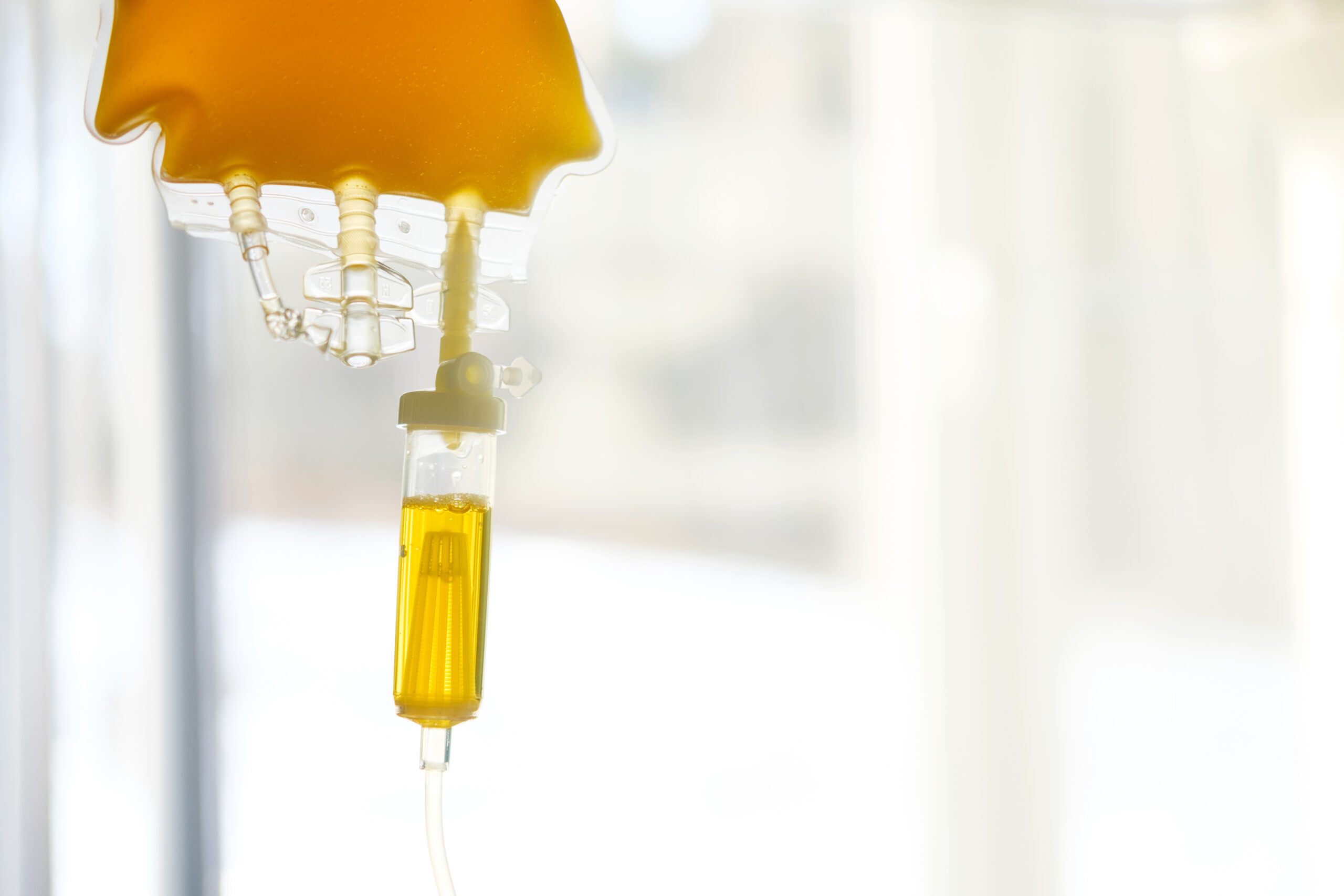
Vitamin and Mineral Supplementation for Alcohol Withdrawal – PLEASE – It is Time to Retire the Banana Bag!
Oh, the banana bag – 1 liter of NS or D5W, 100mg of thiamine, 1mg of folic acid, 1-2g of magnesium, a MVI, ran over 24hrs! Given its yellow color as compared to ordinary maintenance fluids perhaps this is why so many feel that they have accomplished something in the treatment of an alcohol withdrawal patient. But what if you aren’t? What if after all these years of practice you hear the cold hard truth that the banana bag has to be retired because it is not effective treatment? Let us give you the arguments why in this blog!
But first is why we should want to know this information as critical care providers? It is because in a landmark series in Boston, treatment of patients with confirmed Wernicke’s Encephalopathy (WE) with 50–100 mg of parenteral thiamine resulted in only 16% of patients having a complete recovery, whereas 84% of the cohort went on to develop Korsakoff Syndrome (KS) and suffered from significant long-term impairments.(1) And this is a common disease for us to encounter as critical care providers with autopsy studies showing a prevalence of WE in 12.5% of alcoholics in the US.(2,3) The bad news is that this tells us that we are providing an exceedingly low level of care with the current use of a banana bag. However, the good news is that by incorporating some of the information we are discussing here our patients can begin to have better outcomes.
Patients with alcohol misuse disorder present with several issues from a nutritional standpoint that we will discuss separately:
- Thiamine deficiency
- Folate deficiency
- Magnesium deficiency
- Other, rarer, vitamin or mineral deficiencies
- Starvation ketoacidosis
Thiamine has exceptionally poor oral bioavailability. While especially in a deficiency state, the IV formulation is the only practical method of delivery available. However, what is notable with the IV delivery mechanism is that the active rate-limited transfer of thiamine across the blood-brain barrier occurs at only a rate of 0.3 μg/hr/g of brain. Normally one could easily think that would limit or even prevent the amount of thiamine available for transport into the brain, but fortunately enough passive absorption also occurs.(4) Passive absorption across the blood-brain barrier normally constitutes less than 10% of the total thiamine transport in animal models but, with higher parental doses, this fraction can be increased. Hence, the argument for higher dosing is based on the premise that thiamine is transported into the brain by both an active, passive mechanism, and a saturable mechanism, making a steep concentration gradient between the serum and the central nervous system (CNS) an attractive goal of dosing(5).
The other principle to keep in mind with IV dosing is the pharmacokinetics of thiamine. Thiamine is: 1). rapidly eliminated from plasma into the urine, 2). has a plasma half-life of only approximately 1.5 hours, and 3). returns to initial levels within 6–12 hours following a single 50-mg IV dose. What this suggests is that dosing intervals of every 8–12 hours may optimize levels for blood-brain barrier transport.
As supported by the Royal College of Physicians we advocate for 500mg IV q8hrs for 3 days (9 doses).(6)
Supplemental folate in the alcohol withdrawal patient is largely properly provided in the United States with 1mg IV QD for several days. As such, we will not spend time on this topic in this review.
Magnesium, however, is all too often under dosed, and requires a closer examination. Individuals with alcohol use disorder (AUD) have increased magnesium elimination, which leads to magnesium deficiency. Additionally, thiamine and magnesium are interconnected via enzymatic processes. This means that patients with WE may be unresponsive to thiamine treatment in the setting of hypomagnesemia. Furthermore, chronic ethanol ingestion results in an “up-regulation” of the N-methyl-D-aspartate (NMDA) receptor, and this increase in receptors is associated with ethanol withdrawal seizures and generalized hyper-sympathetic response. Not to forget that magnesium is a NMDA receptor antagonist which means it can provide treatment and prophylaxis of withdrawal symptoms and seizures. It is also useful to address atrial fibrillation and torsade de pointes.
Since tissue magnesium concentrations are not fully replete after single doses of magnesium supplementation, several days of supplementation are necessary to restore magnesium concentrations to near-normal. Our recommendation is a dose of approximately 4.5 g of magnesium sulfate for a 70-kg adult on day 1 (usually 5gms for a male and 4gms for a female), followed by 2–3 g/d thereafter for an additional 3 days (usually 3gms for a male and 2gms for a female).
Some patients with an extensive chronic AUD may present in a starved state that begets alcoholic ketoacidosis (AKA). It has been found that AKA in this situation is often underrecognized and may represent the cause of mortality in up to 7% of chronic alcohol users.(7) As a result a comparison of dextrose versus salt-containing fluids suggested that acidosis resolution occurs more quickly in patients receiving dextrose.(8) Therefore we generally advocate for dextrose containing fluids in this patient population.
Finally, a comment on using a multivitamin (MVI) and perhaps other minerals for treatment in this patient population in addition to thiamine, folate, magnesium, and dextrose containing fluids. Though hard data is not available to support the practice. This is possibly due to the wide variety of treatments (multiple vitamins and/or minerals being supplied) and diseases which can be rare, such as scurvy or pellagra. We do not see a harm to this practice, only a possible upside. Hence, a MVI, and perhaps other minerals, may help to begin supplementation in patients at risk for less common nutritional deficiencies seen in extreme malnutrition. In this scenario IV treatment is still likely best, at least initially.
Please provide feedback and comments below on this important topic in critical care medicine.
Authors:
Christopher Voscopoulos, MD, MBA, MS, MLS, FCCP, RPNI
President, Medical Specialists Associates
Board Certified in Anesthesiology, Critical Care, Neurocritical Critical Care, Pain Medicine, Addiction Medicine, Critical Care Echocardiography, Transesophageal Echocardiography, Obesity Medicine, and Board Eligible in Lifestyle Medicine. Registered Physician in Neuroimaging both Transcranial Doppler and Carotid Ultrasound
References:
- Victor, “The Wernicke-Korsakoff Syndrome and Related Neurologic Disorders Due to Alcoholism and Malnutrition.
- Flannery, Adkins, and Cook, “Unpeeling the Evidence for the Banana Bag: Evidence-Based Recommendations for the Management of Alcohol-Associated Vitamin and Electrolyte Deficiencies in the ICU.”
- Torvik, Lindboe, and Rogde, “Brain Lesions in Alcoholics. A Neuropathological Study with Clinical Correlations.”
- Greenwood, Love, and Pratt, “Kinetics of Thiamine Transport across the Blood-Brain Barrier in the Rat.”
- Flannery, Adkins, and Cook, “Unpeeling the Evidence for the Banana Bag: Evidence-Based Recommendations for the Management of Alcohol-Associated Vitamin and Electrolyte Deficiencies in the ICU.”
- Thomson et al., “The Royal College of Physicians Report on Alcohol: Guidelines for Managing Wernicke’s Encephalopathy in the Accident and Emergency Department.”
- Palmiere and Augsburger, “The Postmortem Diagnosis of Alcoholic Ketoacidosis.”
- Miller, Heinig, and Waterhouse, “Treatment of Alcoholic Acidosis: The Role of Dextrose and Phosphorus.”



